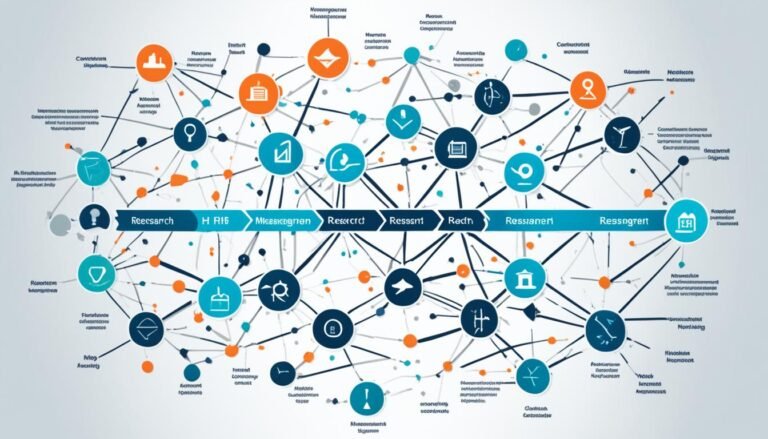A Guide to HR Change Management Techniques
Change management is a crucial process for organizations navigating internal and external transformations. It involves implementing effective HR strategies to drive organizational change, engage employees, and ensure successful change implementation. Change leadership and communication strategies play a vital role in creating a culture of change readiness and fostering employee engagement.
Key Takeaways:
- Implementing HR change management techniques is essential for successful organizational change.
- Change leadership and communication strategies are crucial for engaging employees during the change process.
- Talent management and change readiness are key factors in driving successful change implementation.
- Organizations that prioritize addressing shifting mindsets during change are more likely to achieve success.
- HR professionals play a crucial role in leading and supporting people through change and ensuring effective communication.
The Importance of Change Management in HR
In today’s fast-paced and ever-changing business environment, organizations need to adapt and transform to stay competitive. However, many organizations fail to focus on the “management” part of change management, which is about people. According to a study by McKinsey, addressing mindsets during change can lead to four times more successful change programs.
HR plays a crucial role in leading and supporting people through change. By developing effective HR change management techniques and strategies, organizations can ensure smooth transitions, increased employee engagement, and improved change readiness. Let’s explore the key reasons why change management is vital in HR:
1. Smooth Organizational Change
Change is inevitable, whether it’s due to market shifts, technological advancements, or organizational restructuring. HR professionals equipped with change management skills can guide employees through these transitions, minimizing resistance and maximizing acceptance. They can create and implement change management plans that consider the unique needs and concerns of employees, helping organizations navigate change more effectively.
2. Enhanced Employee Engagement
Employee engagement is crucial for driving success and sustaining organizational change. HR change management techniques focus on fostering open communication, ensuring employees understand the rationale behind change, and involving them in the decision-making process. By actively engaging employees in change initiatives, HR can boost morale and commitment, resulting in increased productivity and positive outcomes.
3. Improved Change Readiness
Change readiness refers to an organization’s ability to anticipate, respond, and adapt to change. HR plays a pivotal role in assessing an organization’s change readiness level and identifying areas for improvement. By implementing change management strategies, HR professionals can enhance change readiness by proactively preparing employees for upcoming changes, addressing fears and concerns, and providing necessary support.
“Change management is not an option; it’s a necessity in today’s dynamic business landscape. HR professionals must lead the way in supporting employees through change and ensuring organizational success.”
As organizations continue to evolve, HR professionals need to develop and refine their change management skills. By prioritizing change management in HR strategies, organizations can navigate complex organizational changes, drive employee engagement, and foster a culture of change readiness.
| Benefits of Change Management in HR | Key Strategies |
|---|---|
| Smooth transitions | Open communication |
| Increased employee engagement | Employee involvement |
| Improved change readiness | Proactive preparation |
Micro Change Management: The New Approach
Micro change management is an innovative approach to handling business transformation. It involves implementing small, fast, and focused steps to drive successful change within an organization. By breaking down big changes into manageable increments, organizations can effectively navigate the complexities of change implementation.
Infosys, a leading company known for its change leadership, has successfully adopted micro change management to achieve desired outcomes. They have implemented this approach by incorporating required behavior through small modifications, continuously measuring progress, and embracing a culture of learning and evolution.
This approach emphasizes the importance of agility and adaptability in managing change. Instead of overwhelming employees and stakeholders with large-scale changes, micro change management allows organizations to focus on individual aspects of transformation, ensuring smoother implementation and greater employee engagement.
“Micro change management offers a new perspective on change implementation. By breaking down complex changes into smaller, more manageable steps, organizations can foster a culture of continuous improvement and adaptability.” – Infosys CEO, Salil Parekh
With micro change management, organizations can make incremental adjustments, closely monitor progress, and address any challenges that arise along the way. This strategy allows for greater flexibility and agility in responding to unforeseen obstacles, ultimately increasing the chances of successful change implementation.
In summary, micro change management offers a fresh approach to change leadership and implementation. By leveraging small, focused steps, organizations can effectively manage business transformation, promote employee engagement, and drive sustainable change.
Types of Change Management
Change management encompasses a variety of approaches to address different types of organizational change. By understanding these different types and their specific requirements, HR professionals can effectively guide their organizations through transformation. The eight types of change management are:
| Type of Change | Description |
|---|---|
| Organization-wide change | Large-scale change that impacts the entire organization, such as a cultural shift or strategic realignment. |
| Strategic change | Change focused on aligning the organization’s goals and objectives with market conditions and competitive forces. |
| People-centric change | Change that emphasizes employee involvement and engagement to foster a positive cultural shift. |
| Personnel change | Change related to the restructuring of roles, responsibilities, and workforce composition within the organization. |
| Structural change | Change that involves modifications to the organizational structure, such as reorganizing departments or hierarchical levels. |
| Technological change | Change driven by advancements in technology, such as implementing new software systems or upgrading hardware. |
| Unplanned change | Change that occurs unexpectedly, often in response to external factors like market shifts or regulatory requirements. |
| Remedial change | Change that aims to rectify issues or shortcomings within the organization, addressing inefficiencies or poor performance. |
Understanding the Different Types of Change
Each type of change management requires a tailored approach to address its unique aspects. Strategic change, for example, may involve extensive planning and communication to ensure organizational-wide buy-in, while personnel change may require a focus on employee training and development to support successful role transitions. By recognizing the specific requirements of each type and applying appropriate change management techniques, HR professionals can help organizations navigate successfully through change.
Signs Your Organization Needs Change
In today’s ever-evolving business landscape, organizations must stay attuned to the needs of their employees and adapt to the rapidly changing market trends. Failing to recognize the signs that indicate the need for change can result in underperformance, decreased market relevance, and employee turnover.
In this section, we will explore key indicators that suggest your organization may be in need of change. By identifying these signs, you can take proactive steps to address the underlying issues and drive transformative change within your organization.
1. Constant Underperformance
Consistent underperformance, whether in terms of financial results, productivity, or customer satisfaction, is a clear indication that something needs to change. This could be an alarm bell signaling a gap between your organization’s current strategies and market demands. Implementing HR change management techniques can help align your organization’s goals, processes, and resources to improve performance and achieve desired outcomes.
2. Inability to Align with Market Trends
Staying connected to the current market trends is crucial for organizations to remain competitive. If your organization consistently struggles to adapt to new technologies, shifts in customer preferences, or emerging market opportunities, it may be a sign that your business model or internal processes need to be reevaluated. By embracing change and implementing effective change management strategies, you can position your organization to seize new opportunities and maintain a competitive edge.
3. Unreliable Market Position
An uncertain or deteriorating market position can indicate the need for change. If your organization is losing market share, struggling to retain customers, or facing intense competition, it’s crucial to reassess your business strategies and make the necessary adjustments. HR change management techniques can enable your organization to adapt swiftly, enhance customer value, and regain a solid market position.
4. Employee Turnover Due to Outdated Technology
Outdated technology or inefficient systems can lead to employee frustration, decreased productivity, and high turnover. If your organization experiences significant employee turnover or struggles to attract and retain top talent, it may be time to invest in technological advancements and improve your workplace environment. By equipping your employees with modern tools and creating an innovative culture, you can enhance employee engagement and reduce turnover.
5. Declining Products and Markets
If your organization is facing declining products or markets with no clear recovery plan, it is a sign that change is necessary. Stagnation in certain product lines or markets can significantly impact your organization’s long-term success. Utilizing change management techniques, you can identify new growth opportunities, diversify your offerings, and pivot strategically to ensure the sustainability of your business.
Recognizing the signs that indicate your organization needs change is the first step toward initiating an effective transformation process. By proactively addressing these signs and implementing HR change management techniques, you can position your organization for success amidst evolving market dynamics.
The Role of HR in Change Management
Change management is a complex process that requires the involvement of various stakeholders within an organization. One of the key players in driving successful change is the HR department. HR professionals play a crucial role in supporting and leading employees through the process of change. Their expertise in HR Change Management Techniques, HR strategies, organizational change, employee engagement, and communication strategies enables them to effectively address the behavioral changes needed during the change process.
Effective communication is a fundamental aspect of change management. HR professionals should ensure that communication channels are open and transparent, providing employees with clear and consistent messages about the change. By doing so, they can help employees understand the rationale behind the change, mitigate fears and uncertainties, and foster a sense of trust and engagement.
Managing employee resistance is another important task for HR professionals during change management. They need to identify potential sources of resistance, such as fear of job loss or concerns about increased workload, and develop strategies to address these concerns. This may involve conducting training programs, providing coaching and support, and creating opportunities for employees to participate in decision-making processes. By actively managing resistance, HR professionals can help minimize disruptions and facilitate a smoother transition.
Furthermore, HR professionals should provide ongoing support to employees throughout the change process. This includes offering resources and tools to help employees adapt to new ways of working, providing training to enhance skills and competencies, and offering emotional support to manage any stress or anxiety associated with the change. By providing such support, HR professionals can promote employee well-being and productivity during the change journey.
In addition to addressing immediate change needs, HR professionals should also focus on creating a culture of change readiness within the organization. This involves fostering an environment where employees are open to change, adaptable, and eager to embrace new opportunities. HR can promote change readiness through talent management strategies, such as identifying and developing change champions within the organization, and creating forums for sharing success stories and lessons learned from previous change initiatives.
“HR professionals are key change agents, using their expertise in HR strategies and change management to navigate the complex terrain of organizational change.”
As change ambassadors, HR professionals are pivotal in ensuring the success of change initiatives. By applying HR Change Management Techniques, effectively communicating the need for change, managing employee resistance, providing ongoing support, and fostering a culture of change readiness, HR professionals can contribute to the overall success of organizational change efforts.
Take a look at the table below to see a breakdown of the key roles and responsibilities of HR in change management:
| Key Roles of HR in Change Management | Key Responsibilities |
|---|---|
| Communication | – Ensuring clear and consistent communication – Addressing employee concerns and questions – Facilitating information flow |
| Employee Resistance Management | – Identifying sources of resistance – Developing strategies to address resistance – Providing training and support |
| Support and Development | – Providing resources for employees – Offering training and skill development programs – Providing emotional support |
| Culture of Change Readiness | – Identifying and developing change champions – Creating forums for sharing success stories – Promoting adaptability and openness to change |
Overcoming Obstacles in Change Management
Common obstacles in change management include employee resistance and communication breakdowns.
Employee resistance is a significant challenge when implementing change within an organization. To overcome this obstacle, it is crucial to build employee change readiness through various techniques:
- Strong leadership: Leaders should effectively communicate the reasons for change and provide clear guidance throughout the process.
- Tools for supervisors and managers: Equip supervisors and managers with the necessary resources to support employees through change, such as training and coaching programs.
- Coaching: Offer individual coaching sessions to employees to address their concerns, fears, and resistance to change.
- Rewards: Recognize and reward employees who successfully adapt to change, reinforcing positive behavior and encouraging others to follow suit.
Additionally, effective communication is crucial for successful change implementation. Communication breakdowns can hinder the understanding and acceptance of change. To overcome this challenge:
- Implement a clear and consistent communication strategy that includes regular updates, open forums, and opportunities for employee feedback.
- Ensure transparency in the communication process, addressing concerns and providing accurate information to build trust and engagement.
- Utilize various communication channels such as emails, team meetings, and collaboration platforms to reach employees at different levels and locations.
By proactively addressing employee resistance and prioritizing effective communication, organizations can improve change readiness and enhance organizational performance.
Managing Varied Types of Organizational Change
Different types of organizational change require different approaches. From mergers and acquisitions to downsizing and bankruptcy, each change presents unique challenges for HR professionals. Understanding these challenges and implementing appropriate strategies is essential for successful change management.
Organizational change can take many forms, and each type brings its own set of HR challenges. Mergers and acquisitions often require integrating new teams, cultures, and systems. Downsizing calls for careful management of employee transition and maintaining morale. Bankruptcy necessitates the delicate balance of minimizing disruption while protecting company assets. HR professionals must navigate these complexities to ensure a smooth transition and minimize the impact on employees.
Employee engagement is crucial during times of change. HR professionals must craft strategies to communicate the reasons for change, address concerns, and provide support to employees whose positions may be affected. By fostering open lines of communication and being transparent about the change process, HR can help mitigate resistance, build trust, and gain employee buy-in.
Additionally, talent management becomes crucial when managing varied types of change. HR professionals must assess workforce capabilities and identify any skill gaps or development needs resulting from the change. By implementing effective talent management strategies, HR can ensure that the organization has the right people in the right positions to drive success during and after the change process.
Overall, managing varied types of organizational change requires HR professionals to be adaptable, strategic, and empathetic. By understanding the unique challenges presented by different types of change and implementing appropriate HR change management techniques, organizations can navigate complex transitions and emerge stronger in the face of change.
HR Challenges in Different Types of Organizational Change
| Organizational Change Type | HR Challenges |
|---|---|
| Mergers and Acquisitions | Integrating cultures, systems, and teams Managing employee transition and morale |
| Downsizing | Minimizing impact on employees Supporting transitioning employees Maintaining morale |
| Bankruptcy | Minimizing disruption Protecting company assets Managing employee concerns and transition |
Change Management Models and Approaches
When it comes to managing organizational change, there are various models and approaches that HR professionals can utilize. These models provide valuable insights and frameworks for effective change management. Let’s explore a few key models and approaches:
Lewin’s Three-step Model
Lewin’s three-step model is one of the most well-known change management models. It consists of three stages: unfreeze, change, and refreeze. The unfreeze stage involves preparing employees for change by breaking down existing mindsets and creating a willingness to change. The change stage focuses on implementing the desired changes and overcoming resistance. Finally, the refreeze stage involves reinforcing the new behaviors and ensuring they become the norm.
Theory E and Theory O
Another approach to change management is the combination of Theory E and Theory O. Theory E emphasizes economic outcomes and aims to enhance shareholder value through cost-cutting and restructuring. On the other hand, Theory O focuses on organizational capability and culture, aiming to build healthy relationships and improve long-term organizational performance. By incorporating both theories, organizations can take a balanced approach to change.
Planned Change Models
Planned change models are systematic approaches that organizations can follow to implement change. These models involve setting clear objectives, developing action plans, and implementing change in a planned and structured manner. Examples of planned change models include McKinsey 7-S model, Kotter’s 8-Step Model, and ADKAR model.
Emergent Change Models
In contrast to planned change models, emergent change models focus on more flexible and adaptive approaches to change. These models recognize that change can emerge organically within an organization and may not always follow a predefined plan. Emergent change models emphasize fostering a culture of innovation, continuous learning, and embracing unforeseen opportunities.
Understanding these change management models and approaches can empower HR professionals to navigate organizational change effectively. By utilizing the right framework and approach, organizations can enhance their change management efforts and achieve successful outcomes.
Overcoming Employee Resistance to Change
Employee resistance is a common challenge that organizations face when implementing change initiatives. It can hinder the success of change management and create roadblocks in achieving organizational objectives. However, HR professionals can employ effective techniques to overcome employee resistance and foster a smooth transition.
Involving Employees in the Change Process
One of the key strategies to overcome resistance is to involve employees in the change process from the beginning. This creates a sense of ownership and engagement, making employees more receptive to the proposed changes. HR professionals can organize brainstorming sessions, focus groups, or town hall meetings to gather employee input and ideas. By giving employees a voice, their concerns and suggestions can be addressed, increasing their willingness to embrace change.
Addressing Expectations and Concerns
It is essential for HR professionals to address the expectations and concerns of employees during the change management process. By communicating openly and transparently, HR can help alleviate fears and provide clarity on how the changes will impact individuals and the organization as a whole. This may involve conducting one-on-one meetings, group discussions, or sending out regular updates to keep employees informed and address any misconceptions or resistance.
Transparent Communication and Support at the Individual Level
Establishing transparent communication channels is crucial in overcoming resistance and gaining employee buy-in. HR professionals should provide clear and consistent messages about the change, its purpose, and the expected outcomes. This can be achieved through various means such as company-wide emails, newsletters, or intranet updates. Additionally, HR should offer individualized support to employees who are struggling with the change. This can involve providing training, mentoring, or counseling services to help them adapt to the new work environment.
By addressing employee resistance through involvement, expectation management, and individualized support, HR professionals can significantly increase the success rate of change initiatives. Overcoming resistance fosters a more engaged and receptive workforce, facilitating a smoother transition and ultimately driving positive organizational outcomes.
| Techniques to Overcome Employee Resistance to Change | Benefits |
|---|---|
| 1. Involving employees in the change process | – Fosters a sense of ownership and engagement – Increases employee buy-in and commitment to change |
| 2. Addressing expectations and concerns | – Alleviates fears and uncertainties – Enhances transparency and trust |
| 3. Transparent communication and support at the individual level | – Provides clarity on the change – Offers personalized assistance for smooth transition |
Communication Strategies in Change Management
Effective communication is crucial for successful change management. HR professionals play a vital role in ensuring that communication strategies are implemented to enhance employee acceptance and engagement during organizational change initiatives.
Here are some key communication strategies to consider:
- Use Multiple Forms of Communication: Employ a variety of channels such as company-wide emails, team meetings, intranet portals, and project management tools to ensure that information reaches employees through different mediums.
- Involve Various Sources: Engage multiple stakeholders, including senior leaders, managers, and subject matter experts, to share consistent messages and reinforce the importance of the change.
- Implement Different Methodologies: Adapt communication methods based on the level of information needed. For broad initiatives, utilize town hall meetings or webinars, while smaller groups may benefit from interactive workshops or one-on-one sessions.
- Tailor Communication: Customize messaging to resonate with different audiences and consider their unique perspectives. This includes using clear and concise language, addressing concerns, and highlighting the benefits of the change.
- Promote Two-Way Communication: Encourage open dialogue by providing forums for employees to ask questions, share feedback, and express their concerns. This can include dedicated Q&A sessions, feedback surveys, or anonymous suggestion boxes.
- Provide Timely and Ongoing Updates: Keep employees informed about the progress of change initiatives, milestones, and any adjustments that may occur. Regularly update communication channels to maintain transparency and trust.
- Utilize Visual Aids: Incorporate visual elements such as infographics, charts, and diagrams to simplify complex concepts and make information more visually appealing and memorable.
By implementing these communication strategies, HR professionals can effectively convey the purpose, benefits, and progress of change initiatives, fostering employee buy-in, engagement, and support.
“Communication is the most important skill any leader can possess.”
– Richard Branson
Conclusion
HR Change Management Techniques play a critical role in navigating organizational transitions and driving successful change. By understanding different change models, addressing employee resistance, and implementing effective communication strategies, HR professionals can bolster employee engagement and contribute to the overall success of change initiatives.
Organizational change is a complex process that requires careful planning and execution. By utilizing appropriate change management techniques, organizations can effectively manage the challenges and obstacles that arise during the change process. This includes addressing employee resistance, fostering open communication, and implementing talent management strategies to ensure the right people are in the right roles.
Effective communication is paramount in change management. HR professionals should employ various communication strategies to engage employees and create a culture of transparency and trust. By involving employees in the change process, providing clear information, and offering support, organizations can enhance employee acceptance and commitment to change.
Furthermore, talent management plays a vital role in change initiatives. HR professionals should identify and develop key talent who can drive change within the organization. By nurturing these individuals and providing them with the necessary resources and support, organizations can build a strong foundation for successful change implementation.







